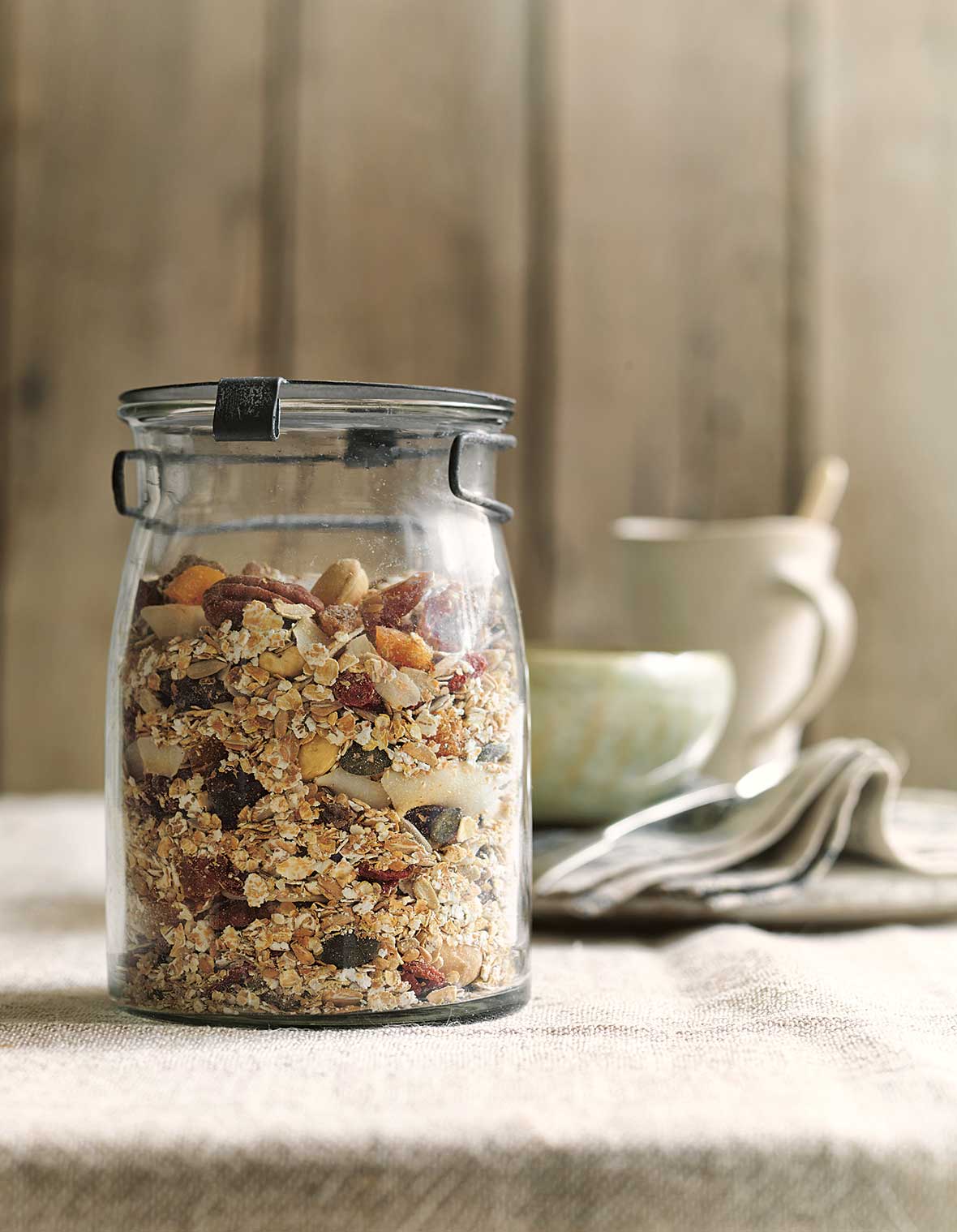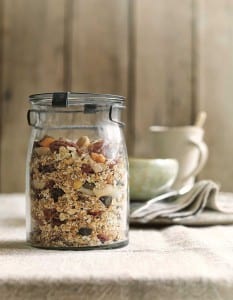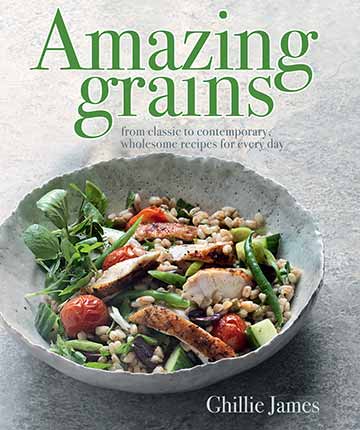
“Homemade muesli is so much less sugary than the expensive store-bought brands that often contain nothing but rather dusty-tasting grains and too many raisins,” asserts author Ghillie James. We think we’ve found a soulmate in her. In her recipe, which follows, she gives you all the perfect proportions for a healthy, easy breakfast cereal so that you can make it your own and vary the grains and fruit and nuts as you please. Your homemade muesli creation is limited only by the confines of your imagination (and maybe the nut and fruit bins at your local grocery store).
As for how to serve the muesli, grabbing a bowlful on the go with a dribble of milk or a blob of yogurt (and a modicum of honey, if you please) isn’t a bad way to go. Neither is heating it with a little milk (whether from a cow or a nut or a seed or a grain or whatever) and tucking into it while hot. Homemade muesli is also swell stirred into your fave boxed breakfast cereal or even sprinkled over arguably less healthful things like ice cream, in case you’re the sort who indulges in breakfast dessert.–Renee Schettler Rossi

Homemade Muesli
Ingredients
- 5 cups whole grain flakes, (such as barley, quinoa, Kamut, rye, or spelt flakes, or a mixture)
- 3 3/4 cups oat flakes or quick-cooking oats
- 2 tablespoons wheat bran, (optional)
- 3 tablespoons seeds, (such as flaxseeds, sunflower seeds, pumpkin seeds, sesame seeds, chia seeds, or a mixture)
- Up to 5 cups mixed dried fruits, (such as chopped apricots or dates, golden raisins, raisins, apples, coconut shavings, goji berries, or a mixture)
- 1 cup mixed nuts, (such as Brazil nuts, walnuts, cashews, almonds, pecans, or a mixture), chopped
- Chunks of chocolate or dried banana chips, (optional)
Instructions
- Preheat the oven to 350°F (180°C).
- If you prefer a raw muesli, mix the grain flakes, oats, and bran, if using, in a large bowl. If you prefer a toasted muesli, mix the grain flakes, oats, and bran, if using, on a rimmed baking sheet and spread the grains so everything is 1/4 to 1/2 inch deep. (You may need 2 baking sheets.) Bake for 6 to 8 minutes, or until the grains look lightly toasted (but not browned) when you stir them with a spoon. Transfer the toasted flakes to a plate or another baking sheet and let cool to room temperature. Dump the flakes in a large bowl.
- Stir in the seeds, dried fruits, nuts, and chocolate or banana chunks, if using, as well as anything else you want to add to the grains. Dump the muesli in an airtight container, cover, and store at room temperature for up to a couple weeks.
Notes
Homemade Muesli Variations
The Author’s Favorite Homemade Muesli Follow the instructions above, using 2 1/2 cups barley flakes, 2 1/2 cups rye flakes, 3 3/4 cups oat flakes, 2 tablespoons wheat bran, 1 1/2 tablespoons pumpkin seeds, 3/4 cup roughly chopped Brazil nuts, 3/4 cup chopped dried apricots and raisins, a handful each broken dried banana chips and coconut shavings, and 3 tablespoons chia seeds. Superfood Homemade Muesli Follow the instructions above, using 5 cups quinoa flakes, 5 cups oat flakes, 1/2 cup goji berries or dried blueberries, 1/2 cup chopped dates or prunes, 4 tablespoons chia seeds, 2 tablespoons flaxseeds, and 4 tablespoons toasted blanched almonds. Gluten-Free Homemade Muesli Follow the instructions above, using 2 1/2 cups gluten-free oats, 5 cups quinoa flakes, 2 tablespoons flaxseeds, 2 tablespoons sunflower seeds, 3/4 cup toasted, roughly chopped, whole almonds, and 3/4 cup dried fruit. For more variations, see the comments below.
Nutrition
Nutrition information is automatically calculated, so should only be used as an approximation.
Recipe Testers’ Reviews
When I saw this homemade muesli recipe, I thought it looked like something my family would enjoy, but I wondered whether the lack of added sugar would make it a little too bland. On the contrary, it was so full of flavor, it was preferred by my entire family to the store-bought sugary version of muesli. I decided to toast half the batch of grains and oats and leave the remaining half raw. Both ended up being well-received, but the combined mishmash that happened when the containers were half empty was everyone’s favorite.
The hardest part about this recipe was finding some of the ingredients I wanted. I thought I’d be picking the grains, but I ended up having to go with what I could find, which was barley and quinoa flakes. They were in the organic food section, but I later found some of the other options in the nuts, cereals, or baking aisles at different grocery stores. You may need to ask someone who works at your store where they are. I made this recipe 3 days ago, and the muesli has taken on so many forms—it’s been added to yogurt (sometimes with honey or a spoonful of jam), ice cream (or, in my husband’s case, a little ice cream was added to a big bowl of muesli), heated in the microwave for about 90 seconds with a little milk for a warm, thick, creamy breakfast, mixed with store-bought cereal to make it a little heartier and more healthful, combined with peanut butter and sliced bananas, and even poured into a cup to be eaten plain. So versatile, nutritious, and yummy. It’s lacrosse season, and the entire family is training for a marathon and half-marathon, so I think I’ll be making this a lot. I’d like to try different versions of the recipe—there are so many options, but I’ll definitely make one with no fruit so each person can add exactly what he or she wants. Fresh or frozen fruit would work great in place of dried if added at the last moment.
This homemade muesli recipe came just in time as we’re trying a mostly plant-based diet in our house. I had never made any type of muesli before, and this couldn’t have been easier! Especially since I went with the raw version. I must admit that the recipe seemed to make way too large of a batch, so I cut the recipe in half. A week later, it’s all gone, and now I’m wishing I’d made the full batch! I used old-fashioned rolled oats, rolled barley flakes, quinoa flakes, wheat bran, flax seeds, and chia seeds. I added dried cranberries, dried blueberries, dried dates, raisins, cashews, and almonds. (And, to a few servings, I added homemade “chocolate chips” made with cocoa, coconut oil, and maple syrup. Num!) It was the perfect healthful breakfast (and sometimes lunch!) with some almond milk. I’m excited to experiment some more and see what else I come up with. And this time I’ll be making the full batch!
This is the perfect DIY code for making homemade muesli. After initially attempting to follow the recipe as written, the devil got the best of me, and I started my own DIY action. I cut the recipe in half, just in case my attempts at being clever were a major fail. I used 1 cup quinoa combined with 1 cup barley and 2 1/2 cups rolled oat flakes. I added 3 tablespoons sunflower seeds and 2 tablespoons pumpkin seeds. I also added 1 cup coconut as well as 1/2 cup chopped walnuts before I roasted it in the oven. (I much prefer my nuts and coconut toasted.) After everything had cooled, I added 1 cup raisins and 1/2 cup chopped prunes. This mix of all the stuff seemed to be just about perfect. I usually eat my muesli with yogurt, and this had the right amount of crunch and toasty goodness.
How much do I love this homemade muesli for breakfast? Our family is trying a reduced-wheat lifestyle right now, so this fit right in. I used 3 cups spelt flakes, 2 cups rye flakes, and 4 cups oat flakes. I left out the bran but increased the flax seeds and pumpkin seeds to 4 tablespoons. We added 3 cups dried blueberries and cherries and 1 cup coconut. We finished with 2 cups of mixed nuts, as we’re more partial to nuts than fruit. Since the nuts were large, I broke them up a bit into slightly smaller pieces. I also toasted the flakes before combining everything for a little more flavor. Baking the flakes took closer to 10 minutes for the grains to be toasted but not browned. When all was said and done, we had 14 cups muesli in our container. This made enough for 28 half-cup servings, which was very filling. I had mine with 1/2 cup vanilla rice milk warmed in the microwave for 1 minute. I will make this again, but it will be a while before I can do so, as there’s so much to go through.
If you strive for a healthy start to your morning, then this homemade muesli recipe is the breakfast solution for you. It yields a delicate sweetness from the dried fruit and offers a great chewy texture. I love the overall earthiness of the flavors. You actually feel healthier just eating it! I counted 14 to 16 cups for the quantity. A little muesli goes a long way. I used the following combination and quantity of ingredients:
2 cups barley flakes
2 cups rye flakes
1 cup spelt flakes
3 3/4 cups old-fashioned rolled oat flakes
2 tablespoons wheat bran
3 to 4 tablespoons pumpkin seeds
1 cup dried apricots
1 cup golden raisins
1 cup dried apples
1 1/2 cups dried unsweetened coconut flakes
1/2 cup dried banana chips
3/4 cup almonds
3/4 cup walnuts
I chose to toast the muesli, which I felt enhanced the flavors. And the next time I make it, I’ll also toast the nuts and coconut flakes to bring out their individual flavors as well. I enjoyed the muesli two different ways—sprinkled over yogurt with some fresh berries and also warmed with milk to yield more of an oatmeal-like consistency. Both ways were delicious, and I can’t wait to make the recipe again!













I’m watching my weight – Does anyone have an idea of how many calories one cup of muesli would be??
Michele, one cup of the muesli using gamut and the 1 cup of dried fruit would be 340 calories.
I’m 13, so just asking if I could change out the 5 cups of whole-grain flakes for something else (possibly cheaper). Could I use Cornflakes or crunched up Weetabix?
Ellie, welcome to Leite’s! We haven’t tried it that way, so we can’t tell you for certain how it will turn out, although if you prefer the texture and taste of those cereals, then it seems the muesli will be more to your liking. Just expect a coarser, crunchier muesli. Kindly let us know how it goes!
Tx David & Renee for your interest. Will keep you updated. Found out that the seeds too need to be soaked. So it’s turning out to be a bit longer than I expected. But if I’m going to do it might as well do it the best way possible! I have poppy seeds too, so am wondering if that too can be added. Any ideas?
Sam, I can’t imagine why they couldn’t be added.
Sam, the seeds don’t need to be soaked, but some say that an overnight soak amplifies the bioavailability of the nutrients contained within. So to soak or not to soak is your call. I wonder if the poppy seeds may all sift to the bottom of the container? But as David said, no real reason not to add them.